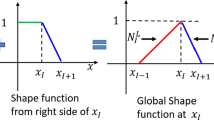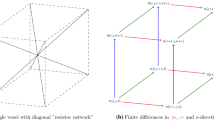Abstract
We discuss numerical schemes of finite element method for solving the continuum mechanics problems. Previously a method of acceleration of calculations was developed which uses the simplicial mesh inscribed in the original cubic cell partition of a three-dimensional body. In this paper we show that the obstacle to the construction of this design may be described in terms of homology groups modulo 2. The main goal of the paper is to develop a method of removing this obstacle. The reaching of the goal is based on efficient algorithms for computing bases of the homology groups which are dual with respect to the intersection form.
Similar content being viewed by others
References
Lapteva, A. V., Yakovlev, E. I. “Index Vector-Function and Minimal Cycles”, Lobachevskii J.Math. 22, 35–46 (2006).
Guskov, I., Wood, Z. J. “Topological Noise Removal”, Graphics Interface Proceedings, 19–26 (2001).
Wood, Z. J., Hoppe, H., Desbrun, M., Shroder, P. “Removing Excess Topology From Isosurfaces”, ACM Transactions on Graphics 23, No. 2, 190–208 (2004).
Lapteva, A. V., Yakovlev, E. I. “Minimal 1-Cycles Generating a Canonical Basis of 2-Manifold’s Homology Group”, Internat. J. Pure and Appl.Math. 31, No. 4, 555–570 (2006).
Ghrist, R., Muhammad, A. “Coverage and Hole-Detection in Sensor Networks via Homology”, Proc. of 4th internat. symposium on Information processing in sensor networks, IEEE Press, 254–260 (2005).
De Silva, V., Glirist, R. “HomologicalSensorNetworks”, Notices Amer.Math. Soc. 54, No. 1, 10–17 (2007).
Bazaikin, Y. V., Baikov, V. A., Taimanov, I. A., Yakovlev, A. A. “Numerical Analysis of Topological Characteristics of Three-Dimensional Geological Models of Oil and Gas Fields”, Mat. Model. 25, No. 10, 19–31 (2013) [in Russian].
Chekmarev, D. T. “Finite Element Schemes on Rare Meshes”, Probl. At. Sci. Techn. Ser. Math. Model. Phys. Proc. 2, 49–54 (2009) [in Russian].
Spirin, S. V., Chekmarev, D. T., Zhidkov, A. V. “Solving the 3D Elasticity Problems by Rare Mesh FEM Scheme”, Finite Diff. Methods, Theory and Appl. 9045 of the Ser. Lect. Notes in Comput. Sci., 379–384 (2015).
Chekmarev, D. T., Zhidkov, A. V., Zefirov, S. V., Krutova, K. A., Spirin, S. V. “Numerical Solving Three-Dimensional Problems of the Theory of Elasticity and Plasticity With the Use of Rare Mesh Variational-Difference and CE Schemes”, Proc. of XI All-Russian Congress on Fundamental Probl. of Theor. and Appl. Mekh., August 20–24, 2015, Kazan (Kazan Univ. Perss, Kazan, 2015), pp. 4048–4050 [in Russian].
Chekmarev, D. T., Krutova, K. A. “On One Property ofHexahedralGrids as Graphs”, Education, science and econom. in high schools and schools. Integration in the international educational space: Proc. of International scientific Conf., September 28–October 2, 2015, Armenia,Goris (PFUR Publishing House, Moscow, 2015), Vol. I, 98–101 [in Russian].
Reese, S., Wriggers, P. “A Stabilization Technique to Avoid Hourglassing in Finite Elasticity”, Int. J.Num. Meth. Engrg. 48, 79–109 (2000).
Golovanov, A. I., Kornishin, M. S. Introduction to the Finite ElementMethod of the Static of Thin Shells (KFTI press, Kazan, 1990) [in Russian].
Krutova K. A. “Numerical Solving Three-Dimensional Dynamic Problems of the Theory of Elasticity and Plasticity on the Basis of an Openwork Variational-Difference Scheme”, Candidate’s dissertation inMathematics ana Physics (UNN, Nizhny Novgorod, 2015) [in Russian].
Zhidkov, A. V., Krutova, K. A., Mironov, A. A., Chekmarev, D. T. “Numerical Solving 3-Dimensional Dynamic Elastic-Plastic Problems Using the Rare Mesh Scheme of the Finite Element Method”, Probl. prochnosi i plastichosti 79, No. 3, 327–337 (2017) [in Russian].
Seifert, H., Threlfall, W. A Textbook of Topology (Academic Press, 1980).
Dold, A. Lectures on Algebraic Topology (Springer, 1995; RKhD, Izhevsk, 2001).
Dubrovin, B. A., Fomenko, A. T., Novikov, S. P. Modern Geometry. Methods and applications. Part III. Introduction to Homology Theory (Nauka, Moscow, 1984; Springer-Verlag, 1990).
Yakovlev E.I. Computational topology (UNN, Nizhny Novgorod, 2005) [in Russian].
Novikov, F. A. Discrete Mathematics for Programmers (Piter, St.-Petersburg, 2000) [in Russian].
Yakovlev, E. I., Tsenova, A. A. “Algorithm for Calculating the Bases of Groups of Two-Dimensional Homology of Branched Triangulated Surfaces”, Trudy Nizhny Novgorod State Tech. University, No. 2 (95), 331–338 (2012) [in Russian].
Edelsbrunner, H., Harer, J. L. Computational Topology. An Introduction (AMS, 2010).
Author information
Authors and Affiliations
Corresponding author
Additional information
Original Russian Text © E.I. Yakovlev, D.T. Chekmaryov, 2018, published in Izvestiya Vysshikh Uchebnykh Zavedenii. Matematika, 2018, No. 9, pp. 81–96.
About this article
Cite this article
Yakovlev, E.I., Chekmaryov, D.T. Topological Methods in One Numerical Scheme of Solving Three-Dimensional Continuum Mechanics Problems. Russ Math. 62, 72–85 (2018). https://doi.org/10.3103/S1066369X18090086
Received:
Published:
Issue Date:
DOI: https://doi.org/10.3103/S1066369X18090086




